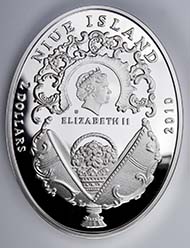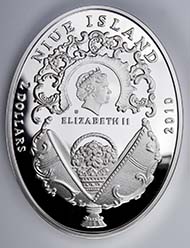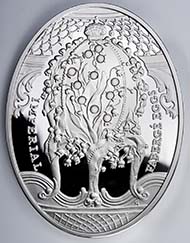September 2nd, 2010 – The Mint of Poland releases a series of collector coins dedicated to the Imperial Fabergé Eggs. The first coin from the series was “Coronation Egg”, the next is “Lily of Valley Egg”.
Niue Island, 2 Dollars, Mint of Poland / Warsaw, silver 925 with Swarovski crystals, ellipse 41,6×55,6 mm, 56,56 g., proof, mintage: 7.000 pieces
Imperial Fabergé Eggs, known also as Tsar’s Fabergé Eggs, are considered masterpieces of the jeweller’s art and a symbol of extravagance and luxury. Created by Peter Carl Fabergé and his assistants for tsars: Alexander III and Nicholas II of Russia, the eggs were made of gold and silver and decorated with enamels and precious stones.
In the original „Lily of the Valley Egg” is enameled translucent rose on a guilloche field and supported on four dull green-gold cabriolet legs, composed of overlapping leaves veined in rose-cut diamonds. The egg is surmounted by a rose-cut diamond and cabochon ruby Imperial crown set, with two bows and quartered by four lines of rose-cut diamonds and decorated with lilies of the valley in pearls and rose-cut diamonds. The stalks are lightly engraved green gold, and the leaves are enameled translucent green on gold.
The surprise consists of three oval miniatures of Nicholas II in military uniform and the Grand Duchesses Olga and Tatiana, his first two children.
This egg was the companion piece to the “Coronation Egg” in the 1979 sale by Wartski of London for $2,160,000 to Forbes Magazine Collection, New York. In 2004 both eggs sold privately for an undisclosed sum to Viktor Vekselberg, Moscow, and have returned to their country of origin.
If you want to see a photo of this egg and read its long, long story, please click here.






